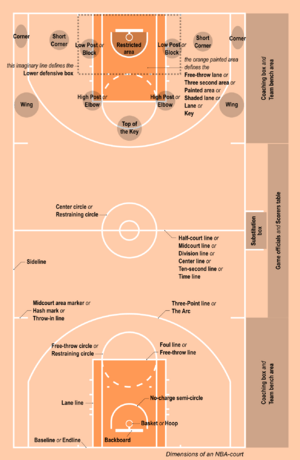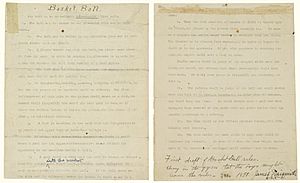Rules of basketball facts for kids
The rules of basketball are the guidelines that control how the game is played, how officials manage it, what equipment is used, and all the procedures involved. While many basic rules are the same everywhere, some differences exist. Major leagues in North America, like the National Basketball Association (NBA) and the NCAA, have their own rule sets. The International Basketball Federation (FIBA) sets rules for games played around the world, and most leagues outside North America use FIBA's rules.
Contents
How Basketball Started: Original Rules
On January 15, 1892, James Naismith published his first rules for the game he invented, called "Basket Ball." The game played back then was quite different from today's basketball. For example, players couldn't dribble the ball, dunk it, or shoot three-pointers. There was no shot clock to limit how long a team could hold the ball. Also, it was allowed to block a shot after it had touched the backboard or was on its way down (called goal tending today).
Here are some key original rules:
- Players could throw the ball in any direction with one or both hands.
- Players could hit the ball with one or both hands, but never with a fist.
- A player could not run with the ball. They had to throw it from where they caught it.
- The ball had to be held in or between the hands. Players couldn't use their arms or body to hold it.
- Pushing, holding, tripping, or hitting an opponent was not allowed. Breaking this rule was a foul.
- If a team made three fouls in a row, the other team scored a goal.
- A goal was scored when the ball went into the basket and stayed there.
- When the ball went out of bounds, the first player to touch it threw it back in.
- The game had two 15-minute halves, with a five-minute break.
- The team with the most goals at the end won.
Naismith's original rules manuscript is now a very valuable document. It is displayed at Allen Fieldhouse at the University of Kansas. Naismith was also the first coach for the Kansas Jayhawks men's basketball team.
Players and Teams: How Things Changed
Naismith's first rules didn't say how many players should be on the court. By 1900, it became standard to have five players per team. At first, players who left the game couldn't come back in. This changed over time: players could re-enter once from 1921, twice from 1934, and then as many times as they wanted from 1945.
Coaches were not allowed to talk to players during the game at first. But from 1949, coaches could talk to their team during a time-out.
In the beginning, a player was removed from the game after their second foul. This limit increased to four fouls in 1911 and then to five fouls in 1945. Most basketball games today, which are 40 minutes long, still use the five-foul limit. In the NBA, where games are 48 minutes long, players are removed after their sixth foul.
Game Clock and Time Limits
The first rule about how long a team could hold the ball came in 1933. Teams had to move the ball past the half-court line within ten seconds of getting possession. FIBA changed this to eight seconds in 2000, and the NBA followed in 2001. The NCAA still uses the 10-second rule for men's college basketball.
The three-second rule was added in 1936. This rule stops offensive players from staying in the area near their opponent's basket (called the "lane" or "key") for more than three seconds. This rule was created to make the game less rough, especially around the basket. Today, it also prevents tall offensive players from just waiting near the basket for an easy shot. When the NBA allowed zone defense in 2001, they also added a three-second rule for defensive players.
The shot clock was first used by the NBA in 1954 to make the game faster. Teams had to shoot the ball within 24 seconds of getting possession. If they didn't, they lost the ball. FIBA added a 30-second shot clock two years later, which was later reduced to 24 seconds in 2000. The shot clock resets when the ball hits the rim or the other team gets possession.
Fouls, Free Throws, and Violations
Dribbling was not part of the original game. It was added in 1901. At first, a player could only bounce the ball once and couldn't shoot after dribbling. By 1909, dribbling meant continuously bouncing the ball, and players were then allowed to shoot after dribbling.
Running with the ball stopped being a foul in 1922 and became a "violation." This means the only penalty is losing possession of the ball. Hitting the ball with a fist is also a violation now.
Goaltending became a violation in 1944. This means you can't block a shot when it's on its way down to the basket or has touched the backboard. Offensive goaltending (touching the ball while it's in the cylinder above the rim) became a violation in 1958.
Free throws were introduced soon after basketball was invented. In 1895, the free throw line was officially set 15 feet (about 4.5 meters) from the backboard. From 1924, the player who was fouled had to shoot their own free throws.
- If a player is fouled while successfully making a shot, they get one free throw.
- If they are fouled while trying to shoot but miss, they get two free throws (or three if they were trying a three-point shot).
- If a player is fouled when they are not shooting, or during a loose ball, the penalty depends on how many fouls the other team has already made in that period. In many leagues, if a team reaches a certain number of fouls, the fouled player gets "bonus" free throws. This often means they get two free throws.
A player has 10 seconds to shoot a free throw. If they take longer, or if the free throw misses the basket, rim, and backboard, it's a "free throw violation." If this happens on the last free throw, the other team gets the ball.
A charge happens when an offensive player runs into a defensive player who has already set their position. If the defensive player is standing still in the offensive player's path, it's usually a charge. No points are scored, and the ball goes to the other team. However, a defensive player cannot draw a charge in the "restricted zone" right under the basket.
Blocking is when a defensive player illegally stops an offensive player's movement, especially during a shot. If a defensive player is moving or not set when contact happens, it's usually a blocking foul.
The "restricted zone" is an arc with a 4-foot (about 1.2-meter) radius around the basket. It was added in 1997 by the NBA to stop defensive players from trying to draw a charge by standing directly under the basket. FIBA adopted a similar arc in 2010.
Equipment Used in Basketball
Basketball was first played with a regular soccer ball. Now, the sport uses its own special ball. The basket is placed 10 feet (about 3 meters) above the court. Originally, a real basket was used, so the ball had to be taken out after each score! Today, we use a hoop with an open net, so the ball just falls through.
Officials and Game Procedures
In the beginning, there was one "umpire" to judge fouls and one "referee" to judge the ball. Today, all officials have equal power to control the game. The NBA added a third official in 1988, and FIBA did the same for international games in 2006.
Using video to help officials make decisions was mostly not allowed. The only exception was to check if a shot was taken before time ran out at the end of a period. This rule was added by the NBA in 2002 and FIBA in 2006. However, college basketball (NCAA) allows instant replay for more things, like checking the shot clock, if a shot was worth two or three points, and for serious fouls.
The "center jump ball," which was used to restart the game after every score, was removed in 1938. Instead, the team that was scored on now gets the ball from behind the end line. This change made the game flow more smoothly. A jump ball is still used to start the game and sometimes to restart play after a "held ball" (when two players have firm possession of the ball at the same time). However, the NBA stopped using jump balls to start the second, third, and fourth quarters in 1975. Instead, teams take turns getting possession to start those quarters.
In 1981, the NCAA started using an "alternating possession" system for most jump ball situations. FIBA adopted a similar rule in 2003. This means that after the opening jump ball, a special arrow on the score table points to the team that gets the ball next for a jump ball situation.
In 1976, the NBA added a rule that allows teams to move the ball to the half-court line after a time-out in the last two minutes of a game. FIBA also adopted this rule in 2006.
International Basketball Rules
The most recent international rules for basketball were approved by FIBA on February 2, 2014, and started being used on October 1 of that year. These rules cover everything from the equipment and court to how teams, players, and coaches should act. They also explain violations, fouls, penalties, and the roles of officials.



